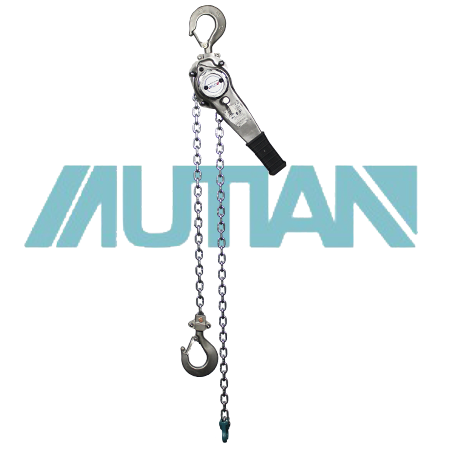 中文版
中文版



Welcome to contact us by phone:0086-0312-7969888
Proper maintenance of a stainless steel manual lever hoist is essential to ensure its safe and reliable operation over time. Here are some general maintenance guidelines to follow:
Regular Inspections: Perform visual inspections of the lever hoist before each use and periodically during operation. Look for signs of wear, damage, or corrosion on all components, including the body, lever, load chain, hooks, and safety mechanisms.
Cleanliness: Keep the lever hoist clean and free of dirt, debris, and contaminants. Use a mild detergent solution and a soft brush to clean stainless steel surfaces, and rinse thoroughly with clean water. Avoid using harsh chemicals or abrasive cleaners that may damage the hoist.
Lubrication: Apply lubricant to moving parts as recommended by the manufacturer to ensure smooth operation and prevent premature wear. Use a lubricant suitable for stainless steel components and apply sparingly to avoid attracting dirt and debris.
Load Chain Maintenance: Inspect the load chain regularly for signs of wear, corrosion, or damage. Clean the chain thoroughly to remove dirt and debris, and lubricate it with a suitable chain lubricant to prevent rust and ensure smooth movement.
Hook Inspection: Check the hooks for wear, deformation, or damage, paying particular attention to the safety latches. Ensure that the hooks are properly seated and engaged with the load and lifting point. Replace any worn or damaged hooks immediately.
Brake Adjustment: Periodically check and adjust the brake mechanism to ensure proper braking action and load control. Refer to the manufacturer's instructions for the correct procedure for adjusting the brake.
Storage: Store the lever hoist in a clean, dry, and well-ventilated area when not in use. Protect it from exposure to moisture, humidity, and corrosive substances that could damage the stainless steel components.
Prevent Overloading: Avoid overloading the lever hoist beyond its rated capacity, as this can cause premature wear and damage to the hoist. Always check the weight of the load before lifting and use appropriate lifting equipment for heavier loads.
Training and Education: Ensure that operators are properly trained and educated on the safe use and maintenance of the lever hoist. Provide training on inspection procedures, proper lifting techniques, and safety precautions to minimize the risk of accidents and injuries.
Manufacturer Guidelines: Follow the manufacturer's recommended maintenance schedule and procedures outlined in the user manual. Adhering to these guidelines will help maintain the hoist's performance, reliability, and safety over its lifespan.
By following these maintenance guidelines and conducting regular inspections, you can help ensure that your stainless steel manual lever hoist remains in optimal condition for safe and efficient lifting operations.
X